In today’s fast-paced world, finding a peaceful oasis to reconnect with ourselves and find inner calm has become increasingly crucial. Enter the meditation garden, a serene outdoor space designed to facilitate relaxation, mindfulness, and a deeper connection with nature. Whether you have a sprawling backyard or a cozy balcony, the opportunity to create your own personal sanctuary for meditation and reflection is within reach.
Meditation garden spaces offer a unique and transformative experience, blending the beauty of nature with the principles of Zen design. By thoughtfully curating the elements within your garden, you can cultivate a harmonious environment that inspires contemplation, reduces stress, and nourishes the soul. From the soothing sounds of cascading water to the calming presence of carefully selected plants, each aspect of your meditation garden can contribute to an overall sense of tranquility and well-being.
Key Takeaways
- Meditation gardens offer a serene outdoor space for relaxation and mindfulness
- Incorporating Zen design principles can create a harmonious and calming environment
- Thoughtfully curated elements, such as water features and plant selection, can enhance the meditative experience
- Designing a personal meditation garden allows you to cultivate a sanctuary for inner peace and reflection
- Creating a meditation garden can provide a therapeutic and rejuvenating escape from the stresses of everyday life
Understanding the Essence of Meditation Garden Spaces
Meditation gardens have their roots deeply embedded in the rich traditions of Zen Buddhism and Eastern philosophy. These tranquil garden retreats are designed to evoke a sense of serene landscape architecture, inviting visitors to disconnect from the bustle of everyday life and immerse themselves in a mindful, meditative experience.
Origins and Traditional Elements of Zen Gardens
The origins of meditation gardens can be traced back to ancient Japan, where Zen Buddhist monks crafted meticulously designed gardens as a means of cultivating inner peace and contemplation. These traditional Zen gardens, or “karesansui,” typically feature a minimalist aesthetic, with carefully arranged rocks, raked gravel, and sparse, carefully pruned vegetation. The symbolism behind these elements represents the essence of the natural world, encouraging visitors to reflect on the impermanence and interconnectedness of all things.
Benefits of Outdoor Meditation Spaces
- Reduced stress and anxiety
- Improved focus and concentration
- Enhanced feelings of relaxation and tranquility
- Increased connection with the natural world
- Inspiration for creative and spiritual exploration
Modern Interpretations of Mindful Gardens
In recent years, the concept of the meditation garden has evolved, with landscape architects and designers reimagining these tranquil spaces to meet the needs of contemporary society. While respecting the core principles of traditional Zen gardens, modern mindfulness garden layouts often incorporate elements such as water features, sculptural elements, and a more diverse plant palette to create a serene, yet visually engaging, retreat for urban dwellers and nature enthusiasts alike. These mindfulness garden layout designs aim to foster a deeper connection with the natural world and promote the restorative benefits of outdoor meditation.
“A garden should make you feel you’ve entered a privileged space – a place not just set apart but reverberating with beauty.”
| Traditional Zen Garden Elements | Modern Mindfulness Garden Features |
|---|---|
| Raked gravel or sand | Flowing water features |
| Carefully pruned bonsai trees | Diverse, low-maintenance plantings |
| Carefully placed rocks and stones | Sculptural elements and artwork |
Choosing the Perfect Location for Your Garden Sanctuary
Creating a captivating nature-inspired meditation space or calming garden sanctuary starts with selecting the ideal location. The spot you choose can significantly impact the overall tranquility and serenity of your outdoor oasis. Let’s explore the key factors to consider when finding the perfect setting for your mindful garden retreat.
Privacy is paramount when establishing your nature-inspired meditation space. Look for an area that offers a sense of seclusion, shielded from the hustle and bustle of everyday life. This could be a secluded corner of your backyard, a private alcove nestled in lush greenery, or a tranquil nook tucked away from main foot traffic.
- Seek out spots that provide a natural barrier, such as trees, shrubs, or walls, to create a sense of enclosure and privacy.
- Consider the proximity to your home or other structures – the closer the better for easy access and integration into your daily routine.
The surrounding calming garden sanctuary should also be a key consideration. Opt for a location that immerses you in the beauty of nature, whether it’s a serene woodland setting, a manicured garden, or a peaceful water feature. The natural elements will help to foster a deeper connection with the environment and enhance the meditative experience.
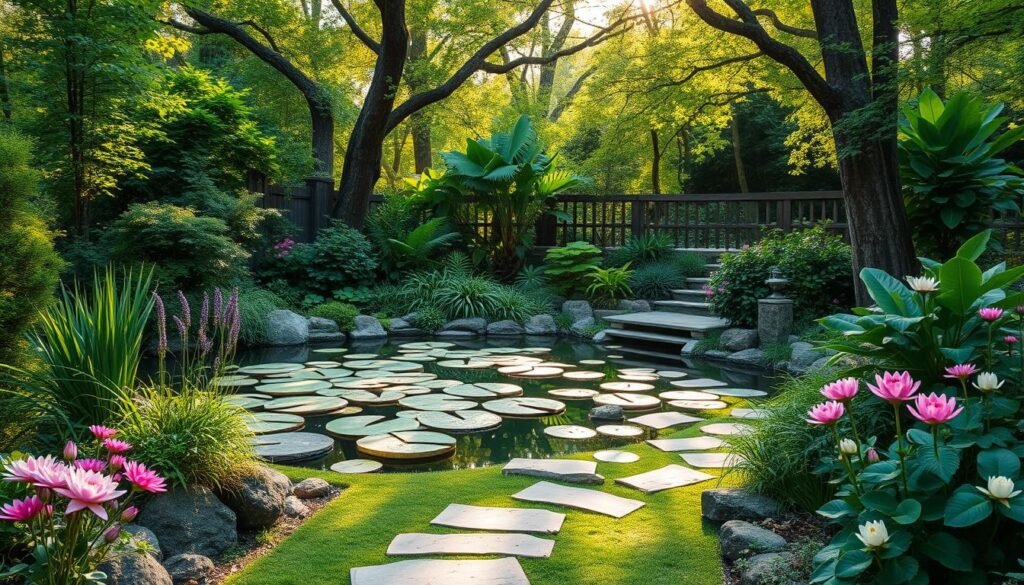
Accessibility is another crucial factor. Ensure that your garden sanctuary is easily accessible, whether you plan to use it for daily meditation, yoga, or simply a peaceful respite. Consider factors like walkways, stairs, or ramps that will make the space inviting and user-friendly.
By carefully selecting the perfect location for your nature-inspired meditation space, you’ll create a haven of tranquility that will nourish your mind, body, and spirit. With the right balance of privacy, natural surroundings, and accessibility, your calming garden sanctuary will become a cherished oasis of serenity.
Essential Elements of a Tranquil Garden Design
Creating a mindful garden oasis that fosters a therapeutic garden environment requires thoughtful consideration of key design elements. From the soothing presence of water features to the calming influence of carefully selected plants, each component plays a vital role in crafting a serene outdoor sanctuary.
Water Features and Their Calming Effects
The gentle sound of flowing water has long been recognized for its ability to promote relaxation and tranquility. Incorporating water elements such as fountains, ponds, or cascading streams can instantly transform a garden into a meditative haven. The mesmerizing movement and soothing ambiance of water features invite visitors to pause, breathe deeply, and immerse themselves in the present moment.
Plant Selection for Serenity
- Fragrant flowers like lavender, jasmine, or lilies can evoke a sense of calm and well-being.
- Lush, verdant foliage plants such as ferns or hostas create a peaceful, lush atmosphere.
- Evergreen shrubs and trees provide a grounding, year-round presence, contributing to the therapeutic garden environment.
Incorporating Natural Stone Elements
The inclusion of natural stone elements, such as boulders, stepping stones, or rock gardens, can further enhance the tranquil ambiance of a mindful garden oasis. These earthy, grounded materials connect the space to the natural world, fostering a sense of balance and harmony. Strategically placed stone features can also help define pathways, create seating areas, or serve as focal points, guiding visitors on a meditative journey through the garden.
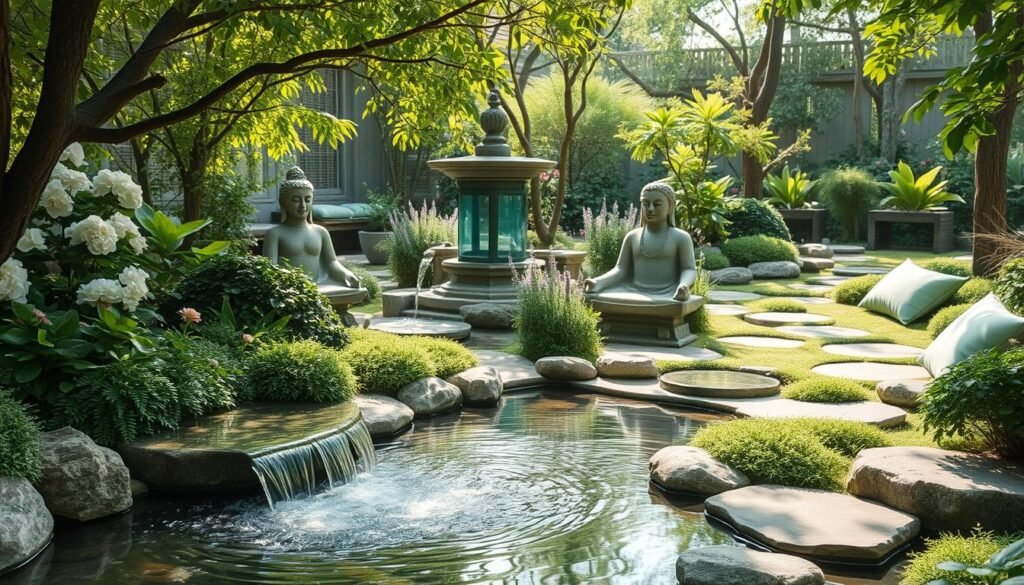
Creating Comfortable Seating and Meditation Areas
Designing a tranquil garden retreat for outdoor meditation requires thoughtful consideration of the seating and meditation areas. These spaces should not only reflect the serene atmosphere but also provide comfort and support for extended periods of mindful practice.
When selecting seating options for your outdoor meditation area, prioritize ergonomics and durability. Opt for low-profile benches, cushioned meditation stools, or even a simple stone or wooden platform. The key is to ensure proper alignment and support for your spine, allowing you to maintain a comfortable posture throughout your meditation sessions.
Incorporating natural materials, such as weathered wood, smooth river stones, or sleek concrete, can help create a tranquil garden retreat that seamlessly blends with the surrounding greenery. Pair these seating elements with soft, plush cushions or outdoor-friendly pillows to enhance the overall comfort and inviting ambiance.
| Seating Material | Advantages | Considerations |
|---|---|---|
| Wood | Naturally warm and earthy, durable in outdoor conditions | Requires regular maintenance and weatherproofing |
| Stone | Sturdy, low-maintenance, and blends well with natural surroundings | Can be cold and uncomfortable for extended sitting |
| Concrete | Sleek, modern aesthetic, durable, and easy to clean | Can be hard and uncomfortable without cushioning |
By thoughtfully designing the seating and meditation areas in your outdoor meditation area, you can create a serene and inviting space that encourages focused practice and deep relaxation within your tranquil garden retreat.
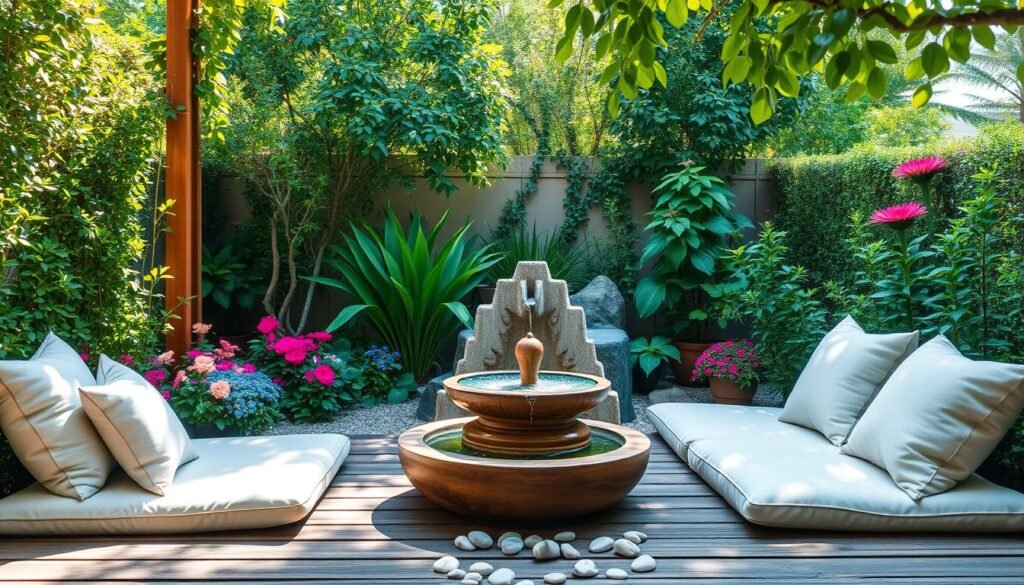
Incorporating Mindful Garden Features and Focal Points
Creating a serene zen garden space goes beyond simply arranging plants and hardscaping. To truly capture the essence of mindfulness, it’s essential to incorporate thoughtful design elements that enhance the meditative experience. From the captivating rhythms of raked sand gardens to the soothing chimes carried by the wind, these carefully curated features can transform your outdoor oasis into a true sanctuary for the senses.
Zen Sand Gardens and Raking Patterns
The zen sand garden, or karesansui, is a hallmark of traditional Japanese garden design. By methodically raking the sand into intricate patterns, you can create a captivating focal point that calms the mind and invites deep reflection. The repetitive motions of raking the sand can even become a meditative practice in itself, allowing you to lose yourself in the moment and achieve a sense of inner peace.
Statuary and Artistic Elements
Strategically placed statues, sculptures, and other artistic elements can serve as powerful focal points within your zen garden design. Whether it’s a serene Buddha figure, a whimsical animal figurine, or a striking modern piece, these thoughtfully chosen elements can draw the eye and inspire contemplation. By incorporating works that resonate with your personal aesthetic and spiritual beliefs, you can further cultivate a sense of serene landscape architecture that speaks to your individual journey.
Wind Chimes and Sound Elements
The gentle, soothing sounds of nature can play a significant role in creating a truly immersive meditation garden. Wind chimes, for instance, can harness the breeze to produce a calming melody that enhances the tranquil ambiance. Carefully selected water features, such as a bubbling fountain or a delicate stream, can also contribute to the meditative soundscape, masking distracting urban noises and helping you to fully disconnect from the outside world.
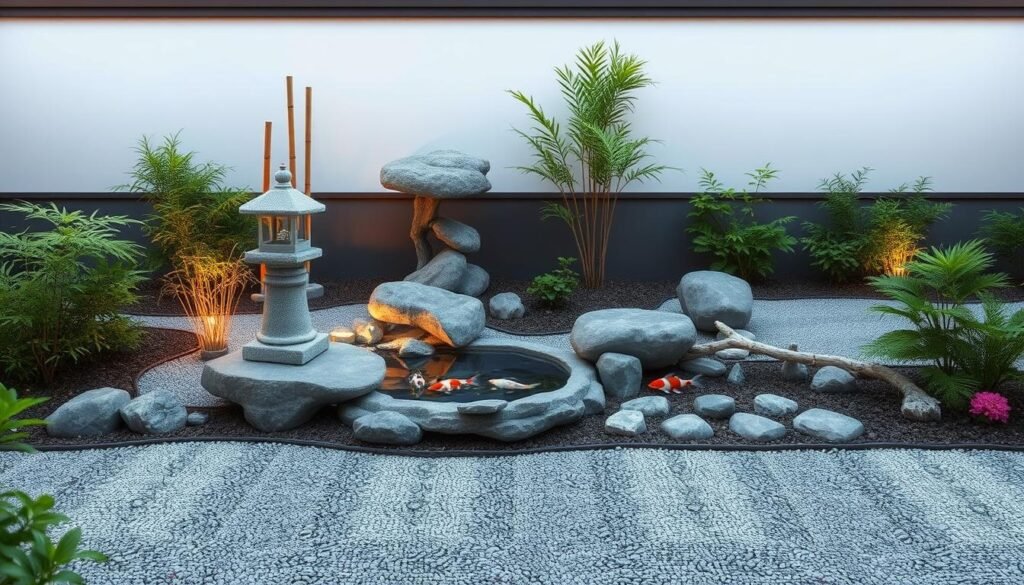
“The sound of water is worth more than all the poets’ words.”
– Terri Guillemets
Seasonal Planning for Year-Round Tranquility
Cultivating a meditation garden spaces that provides a soothing, nature-inspired environment year-round requires careful seasonal planning. By strategically incorporating plants, design elements, and adaptable features, you can ensure your nature-inspired meditation space remains a tranquil haven throughout the changing seasons.
Spring ushers in a vibrant awakening, with blooming flowers and lush greenery. Consider planting early-flowering bulbs like daffodils and tulips to herald the arrival of the new season. Incorporate evergreen shrubs and trees to maintain visual interest even as deciduous plants shed their leaves.
- Opt for fragrant perennials like lavender, jasmine, and lilies to delight the senses.
- Include water features like a gentle fountain or reflecting pool to enhance the serene ambiance.
As summer arrives, focus on establishing a shaded respite from the heat. Strategically place shade structures, trellises, or tall, densely foliaged plants to create pockets of cool, comfortable spaces for meditation and relaxation.
In the fall, embrace the changing hues and textures of the season. Incorporate autumnal plants like Japanese maples, ornamental grasses, and chrysanthemums to celebrate the natural cycle. Consider adding seating areas protected from wind and rain to encourage year-round use of your garden oasis.
| Season | Recommended Garden Elements |
|---|---|
| Spring |
|
| Summer |
|
| Fall |
|
By thoughtfully planning your meditation garden spaces with the changing seasons in mind, you can create a nature-inspired meditation space that remains a tranquil oasis throughout the year.
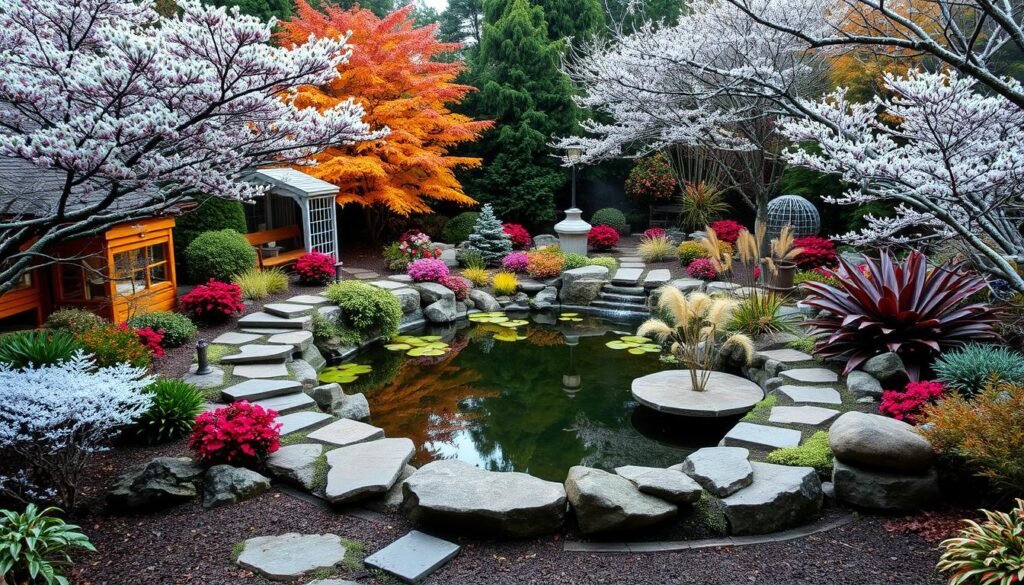
Lighting Your Therapeutic Garden Space
Crafting a calming garden sanctuary or a mindful garden oasis requires thoughtful consideration of lighting. Proper illumination can transform your outdoor retreat into a serene and inviting space for meditation and relaxation.
Natural Light Considerations
Maximizing natural daylight is crucial in creating a tranquil ambiance. Strategically place seating areas and meditation spots to take advantage of the garden’s optimal sun exposure throughout the day. Utilize large windows, skylights, or even a pergola with open slats to allow the warm, gentle glow of sunlight to filter in.
Evening Illumination Options
As the sun sets, introduce soft, subtle lighting to maintain the garden’s serene atmosphere. Incorporate path lights, uplighting for trees and architectural features, and discreet spotlights to highlight key elements. Avoid harsh, glaring lights that could disrupt the calming mood.
Solar-Powered Solutions
- Embrace eco-friendly solar-powered lighting options that seamlessly blend into the garden’s design.
- Solar-powered lamps and path markers provide a sustainable way to illuminate your calming garden sanctuary or mindful garden oasis.
- These renewable energy sources not only reduce your carbon footprint but also create a warm, natural ambiance without the need for electrical wiring.
| Lighting Type | Benefits | Considerations |
|---|---|---|
| Natural Daylight | Enhances the garden’s serene atmosphere, provides warmth and gentle illumination | Requires strategic placement of seating and meditation areas to optimize sunlight exposure |
| Soft, Subtle Evening Lighting | Maintains a calming ambiance after sunset, highlights key garden features | Avoids harsh, glaring lights that could disrupt the tranquil mood |
| Solar-Powered Lighting | Eco-friendly, sustainable, creates a natural ambiance without electrical wiring | Requires careful selection and placement to seamlessly integrate into the garden’s design |
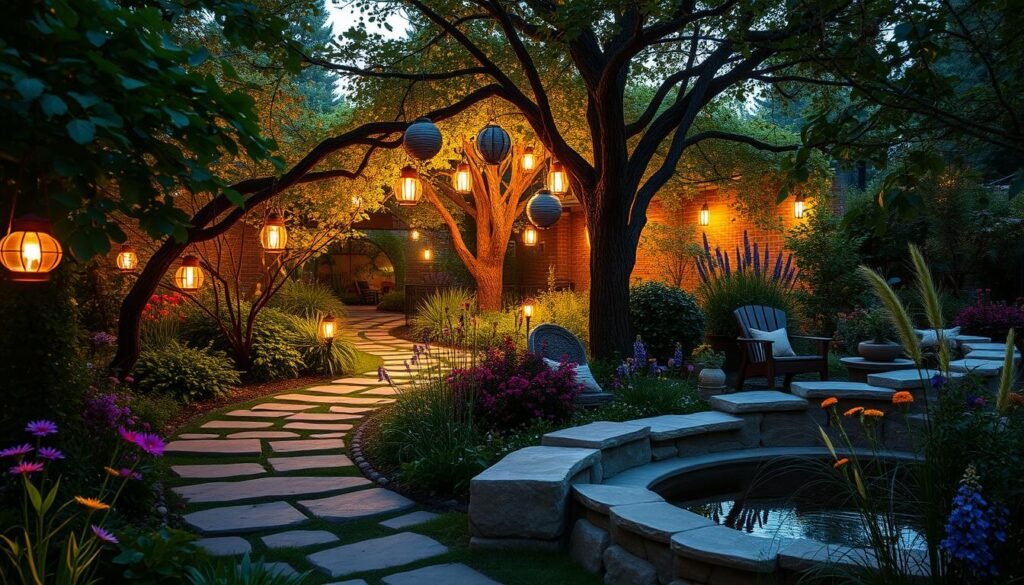
By thoughtfully incorporating natural light, subtle evening illumination, and solar-powered solutions, you can transform your outdoor space into a true calming garden sanctuary or mindful garden oasis, where relaxation and tranquility await.
Maintaining Your Mindful Garden Oasis
Creating a tranquil therapeutic garden environment is just the first step. To ensure your tranquil garden retreat remains a serene sanctuary, regular maintenance and care are essential. By adopting sustainable gardening practices and implementing low-maintenance strategies, you can effortlessly keep your mindful oasis in pristine condition.
Start by selecting plants that thrive with minimal attention. Native species adapted to your local climate often require less watering and pruning, allowing you to enjoy your garden without constant upkeep. Incorporate drought-tolerant succulents, fragrant herbs, and resilient perennials to create a self-sustaining ecosystem.
- Choose low-maintenance plants that are well-suited to your climate and garden conditions.
- Incorporate native species to reduce water and maintenance needs.
- Utilize mulch around plants to suppress weeds and retain moisture.
Regular weeding, pruning, and deadheading will ensure your garden remains tidy and visually appealing. Set aside a few minutes each week to gently tend to your space, removing unwanted growth and enhancing the overall aesthetic. This mindful practice can be a meditative experience in itself, connecting you more deeply with your therapeutic garden environment.
| Maintenance Task | Frequency |
|---|---|
| Weeding | Weekly |
| Pruning | Seasonal |
| Deadheading | Monthly |
| Mulching | Annually |
By implementing these simple yet effective maintenance strategies, you can ensure your tranquil garden retreat remains a haven of serenity for years to come. Embrace the meditative process of caring for your mindful oasis, and let the rhythmic tasks become an integral part of your wellness journey.
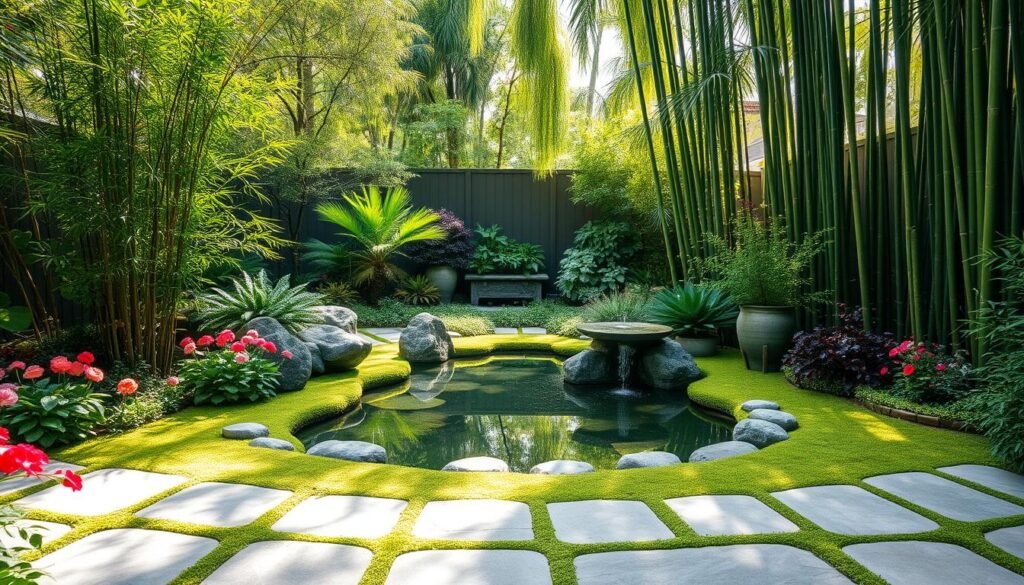
Conclusion
As you embark on your journey to create the perfect meditation garden space, remember that this is a rewarding process that will provide you with a personal oasis of tranquility and mindfulness. By incorporating the key elements of a Zen-inspired outdoor sanctuary, you can transform your garden into a serene retreat that nourishes your soul and ignites your senses.
Whether you opt for a minimalist design with carefully curated natural elements or a more lush and vibrant interpretation, the benefits of having your own meditation garden will be far-reaching. From the soothing sounds of flowing water to the captivating patterns of a raked sand garden, your outdoor meditation space will become a haven where you can disconnect from the stresses of daily life and reconnect with the present moment.
As you continue to refine and maintain your meditation garden, take pride in the fact that you have created a personal refuge that will provide you with lasting peace, relaxation, and inspiration. Embrace the journey, experiment with new ideas, and allow your garden to evolve and adapt to your changing needs and preferences. With dedication and a mindful approach, your meditation garden will thrive and become a treasured sanctuary for years to come.
FAQ
What are the origins and traditional elements of Zen gardens?
Zen gardens, also known as Japanese rock gardens, have their roots in the ancient traditions of Buddhist meditation practices. These gardens often feature carefully arranged rocks, gravel, sand, and minimal vegetation to create a serene, minimalist landscape that encourages introspection and mindfulness.
What are the benefits of having an outdoor meditation space?
Outdoor meditation spaces, or meditation gardens, can provide numerous physical and mental health benefits. Being in nature has been shown to reduce stress, improve mood, and enhance overall well-being. The combination of tranquil surroundings and the act of mindfulness can lead to a deeper connection with the present moment and a greater sense of inner peace.
How can I choose the perfect location for my meditation garden?
When selecting a location for your meditation garden, consider factors such as privacy, natural surroundings, and accessibility. The space should feel secluded and removed from the hustle and bustle of daily life, allowing you to fully immerse yourself in the meditative experience. Additionally, look for areas with a calming, nature-inspired atmosphere, such as near a wooded area or with a view of a serene body of water.
What are some essential elements of a tranquil garden design?
Key elements of a tranquil garden design include water features, such as fountains or ponds, that create a soothing, ambient sound. Carefully selected plants known for their calming properties, like lavender or bamboo, can also contribute to the serene atmosphere. The incorporation of natural stone elements, such as boulders or pathways, can help ground the space and foster a sense of connection with the natural world.
How can I create comfortable seating and meditation areas in my garden?
When designing seating and meditation areas in your garden, prioritize comfort and ergonomics to support extended periods of mindfulness practice. Consider incorporating cushions, low benches, or even a meditation platform made from natural materials like wood or stone. Ensure the seating is positioned to take advantage of the garden’s best vistas and most peaceful areas.
How can I incorporate Zen-inspired features and focal points?
Zen-inspired features, such as a sand garden with raking patterns, can be a beautiful and meaningful addition to a meditation garden. Statues, sculptures, or other artistic elements can also serve as focal points, drawing the eye and fostering a sense of contemplation. The gentle chimes of wind chimes or the soothing sounds of a water feature can further enhance the meditative ambiance.
How can I maintain my meditation garden’s tranquility throughout the seasons?
Maintaining a meditation garden’s tranquility year-round involves careful plant selection and design choices. Incorporate evergreen plants, seasonal blooms, and elements that offer visual interest in different seasons. Adapt the space to accommodate various weather conditions, such as providing shade or shelter as needed, to ensure the garden remains a peaceful retreat in all seasons.
How can I use lighting to enhance the serenity of my meditation garden?
Thoughtful lighting can play a crucial role in creating a serene atmosphere in your meditation garden. During the day, maximize natural light to take advantage of the garden’s inherent beauty. In the evening, incorporate gentle, low-level illumination, such as solar-powered path lights or subtle uplighting, to maintain a calming ambiance without disrupting the meditative experience.
What are some tips for maintaining my meditation garden oasis?
To keep your meditation garden well-maintained and inviting, focus on sustainable gardening practices and low-maintenance plant selections. Regular weeding, pruning, and cleaning can help preserve the space’s tranquil aesthetic. Consider incorporating features like automated irrigation systems or drought-tolerant plants to minimize the time and effort required for upkeep, allowing you to fully enjoy the garden’s restorative benefits.

Hello, I’m Jimmy, founder of Jimmy Cozy Life. I’m here to help you create a home that feels warm, stylish, and balanced. With ideas for decor, celebrations, wellness, and DIY projects, my goal is to share practical tips and a bit of inspiration to make your space truly special.
Disclosure: This post contains affiliate links. If you click and make a purchase, we may receive a small commission at no extra cost to you. The content on this website was developed with assistance from AI.



